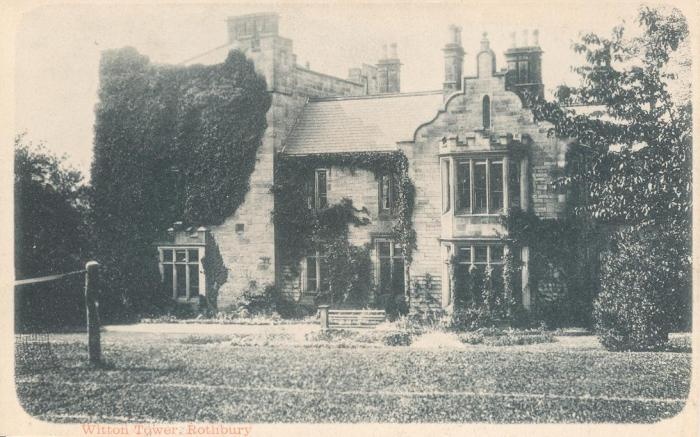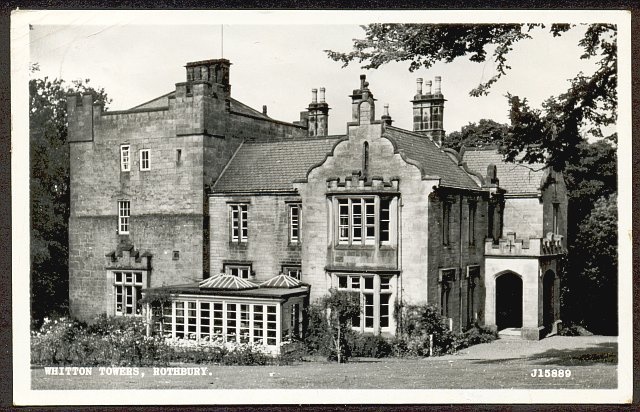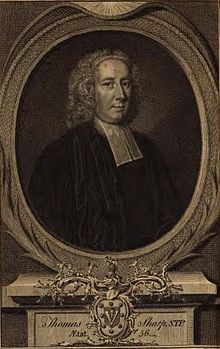History
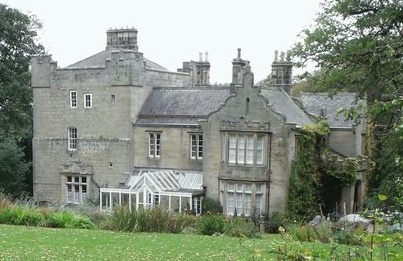
A recent Photograph taken April 2012
Early records show the name as Witton Tower, however, as seen on the postcard, it later became Whitton Tower.
The next 2 postcards are published here with the kind permission from Andrew of the www.castleduncan.com forum
I thought it would be a good start to see the changes in just this short time. Check out the conservatory you'll see what I mean.
and also the growth of the creeper, which is a bit more advanced than the photos (1910 &1915) in Mary Scott's collection.
1435-1474 Alexander Cooke, rector of Rothbury,
A weathered mural shield on the west wall of the tower has a coat of arms either of the Umfravilles or of Alexander Cooke, who probably built the upper storey of the tower. The reigning rector is still lord of the manor although the lands and village of Whitton are his no longer.
after 1458 before 1474 George Percy rector of Rothbury and of Calderbeck (b.1424 d.1474)
only evidence of this post was noted in his will 1474 where he says he was Rector of Rothbury and Calderbeck. he was ordained in 1458
He was a triplet and the sixth son of Henry Percy second Earl of Northumberland.
1499 John Yelton rector of Rothbury
1512-1523 Canon John Clark(or Clerk), Canon of Carlisle and rector of Rothbury
He was poisoned in Germany 1540 when he was ambassador to the Duke of Cleves to render a reason for King Henry VIII divorce from Lady Ann of Cleves (sister to the Duke).
1526 Thomas Magus rector of Rothbury.
1530 - The Church of England and the English Reformation
The English Reformation was a series of events in 16th century England by which the Church of England broke away from the authority of the Pope and the Catholic Church.
The history of the Church of England has its origins in the last five years of the 6th century in the Anglo-Saxon Kingdom of Kent, and the Gregorian mission of Saint Augustine. The Church of England emphasises continuity through apostolic succession and traditionally looks to these early events for its origins rather than to the changes brought about by the English Reformation. Events such as Henry VIII's schism with the Roman Catholic Church or the excommunication of Elizabeth I or the wider Reformation in mainland Europe all contributed to the development of the Church of England as it is now established, but are regarded as a continuation of the arrival of the One, Holy, Catholic, and Apostolic Church to the British Isles.
1550 Dr Roger Watson
Although appointed rector of Rothbury he never resided in Rothbury. He was a monk before the reformation. It was during his appointment that Bernard Gilpin "Apostle of the North" came to Rothbury on regular visits.
1561 Edward Mitchell, rector of Rothbury
1566 Dr George Neville, rector of Rothbury
1567 or 1577 Willimus Talentyre, rector of Rothbury alternate name William Tallentire (fl 1556-1577)
1584 Charles Slingby, rector of Rothbury
1628 Dr John Manby, rector of Rothbury
1635 Richard Smith, rector of Rothbury
1643 Ambrose Jones, rector of Rothbury
1656 Thomas Cotes, rector of Rothbury
1661 John Garthwait, rector of Rothbury
1665 Thomas Cotes (Coates), rector of Rothbury
1669 Henricus Garnett, rector of Rothbury
1679-1720 Dr. John Thomlinson, rector of Rothbury (d.1720)
On his arrival in 1679, he found the parish, a chaos of confusion- its revenues alienated the Church and the Rectory both in a ruinous condition- therefore the whole of his energies were devoted to the important task of restoring his new parish to something like the order which he succeeded in doing in a most commendable manner. The Middle School bears his name. He founded a school with two masters "to teach the English, Latin and Greek tongues
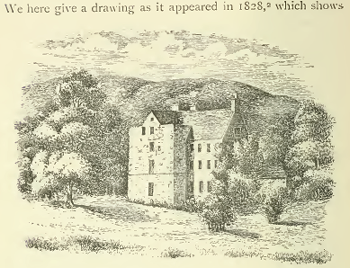
1813-1822 Leveson Vernon Harcourt, rector of Rothbury (b.1788 d.1860)
He went on to be Chancellor of York and making way for his brother Charles who succeeded him as rector of Rothbury.
1822-1870 Canon Charles Vernon Harcourt, rector of Rothbury (b.1798 d.1870)
He greatly enlarged and modernised the property and added the East Wing (now known as "The Rectory"), which became the main entrance to the property in about 1830. The date has always been a bit sketchy with some accounts saying 1830, some as much as 1860. However, I was up on the roof of The Rectory and spotted this last original rainwater hopper, you can see "CVH 1839" in the lead work - CVH = 'Charles Vernon Hardcort' and the year) - all the other lead work was removed for Cast Iron and the new plastics, so it was a rare and lucky find. It looks like from the drawing (1828) that the Tower had some work carried out on it in the similar style, This work appears to be the upper part of the Tower and the windows (note the Battlements and the enlarged windows), Gothic Revival which was popular in the Victorian period. He added his Coat of Arms over the front entrance. A fine example of this architecture was Allerton Castle North Yorkshire.
1871-1886 Dr. George Henry Ainger, rector of Rothbury
He remodelled the interior
1887 Arthur Octavius Medd, rector of Rothbury
1894-1900 Canon Edward Mallet Young, rector of Rothbury,
He remodelled the interior
1900-1934 Canon William Goodman Ress, rector (and rual dean) of Rothbury
Last of the Rectors of Rothbury to have live in Whitton Tower. Although while the deeds had reference to his name (by Cllr Angus Watson as known to owned the property for the last 16yrs prior to 1934). It is understood that he died at his home in Bideford, North Devon on 2nd Sept 1934.
1934 Cllr Angus Watson of Newcastle
He purchased the land and properties called Witton Tower from the church. He had already acquired the vicarage glebe lands as well as nearby Whitton Grange, to preserve what he called the "amenities of the district". Within a year, he had leased Whitton Tower to Newcastle City Council for a children's convalescent home, a use it retained until 1983 one of the stipulations was for the name to be - The Ethel Watson Childrens Convalescent Home. Cllr Angus Watson rented the property to the Newcastle City Council until 1957 where upon he gifted the property.
1937-1983 The Ethel Watson Childrens Convalescent Home.
The City Council added a two storey extention to the North end of the East Wing. That was used as a bath and toilet block.
The council provided short term and long term care here.
1983-1987 The Del-Greco family divided the property and land up into several units.
They live there as a family in the separated units. Then one by one sold them off, as privately owned residences which they are currently. Several units had new bungalows built.
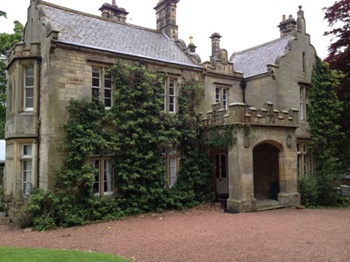

On the high ground to the South East, he added a round tower known at that time as "The Doctors Folly" but became late known as "Sharps Folly", in order to give employment to the village masons when out of work. Dr. Sharp, besides being a learned divine, studied the occult science of astrology, and this tower may have served his interest.
Dr Thomas Sharp's 9th son - Granville Sharp (b.1735-d.1813), one of the leading and most influential figures involved in the emancipation and abolition of the slave trade. Granville Sharp, a remarkable man, commonly regarded as ‘the father of the abolitionist cause’, was born in Durham in 1735. The ninth and youngest son of the Rev Thomas Sharp, and grandson of John Sharp, Archbishop of York, he was educated at Durham Grammar School before being apprenticed to a quaker linendraper in Tower Hill, London in 1750. excerpt taken from Adam Mathews Publications
1784-1796 Dr. Edward Aurial Hay Drummond, rector of Rothbury (d.1813)
He then made extensive additions to Whitton Tower
1794 Dr George Watson, rector of Rothbury
see drawing of Whitton Tower as it appeared in 1828 - the sketch is to highlight the Bastille - (fortified animal enclosure) on the side of the house slightly obscured by trees

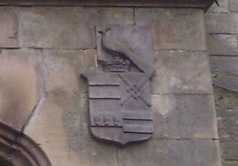
I came across this very pretty embossed postcard of Whitton Tower, in an online auction, just recently (Jan 2013). It was published by G.H. Grey, Rothbury, and has a postage stamp dated: AU 8 1911. It looks to me like it has been enhanced, note the left and right side show a darken area - these should be large trees but the picture shows a very neat line near to the centre line of the picture. Artistic licence presumably. I think this may be the earliest postcard of Whitton Tower out there, There isn't much creeper growth on the Pele which can be seen in Mary Scott's collection starting in 1910, So, given creeper growth rates this picture must be a lot earlier. if anyone knows differently please let me know. I'm very interested in the dates of the two postcards that follow this one.
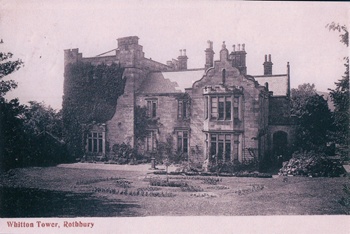
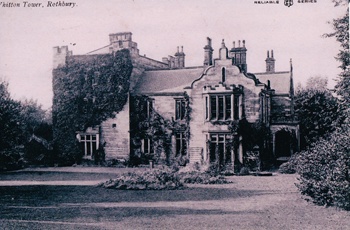
The next 2 postcards came from Mary Scott's collection. She has a fascinating set of photographs and postcards of the area and over time showing subtle changes.
Post Card 1 is believed to have been taken in 1910 Post Card 2 is believed to have been taken in 1915
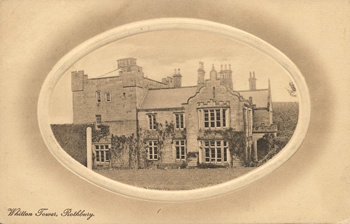
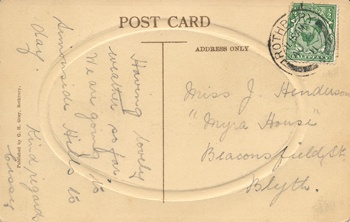
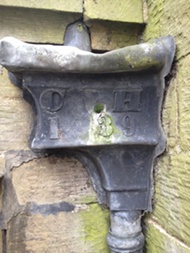
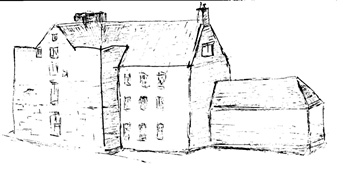
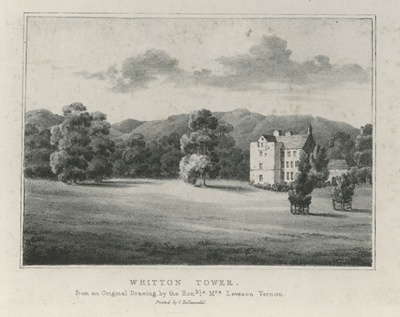
The Original Drawing by Mrs Leveson Vernon above
and snippet taken as seen to the left.
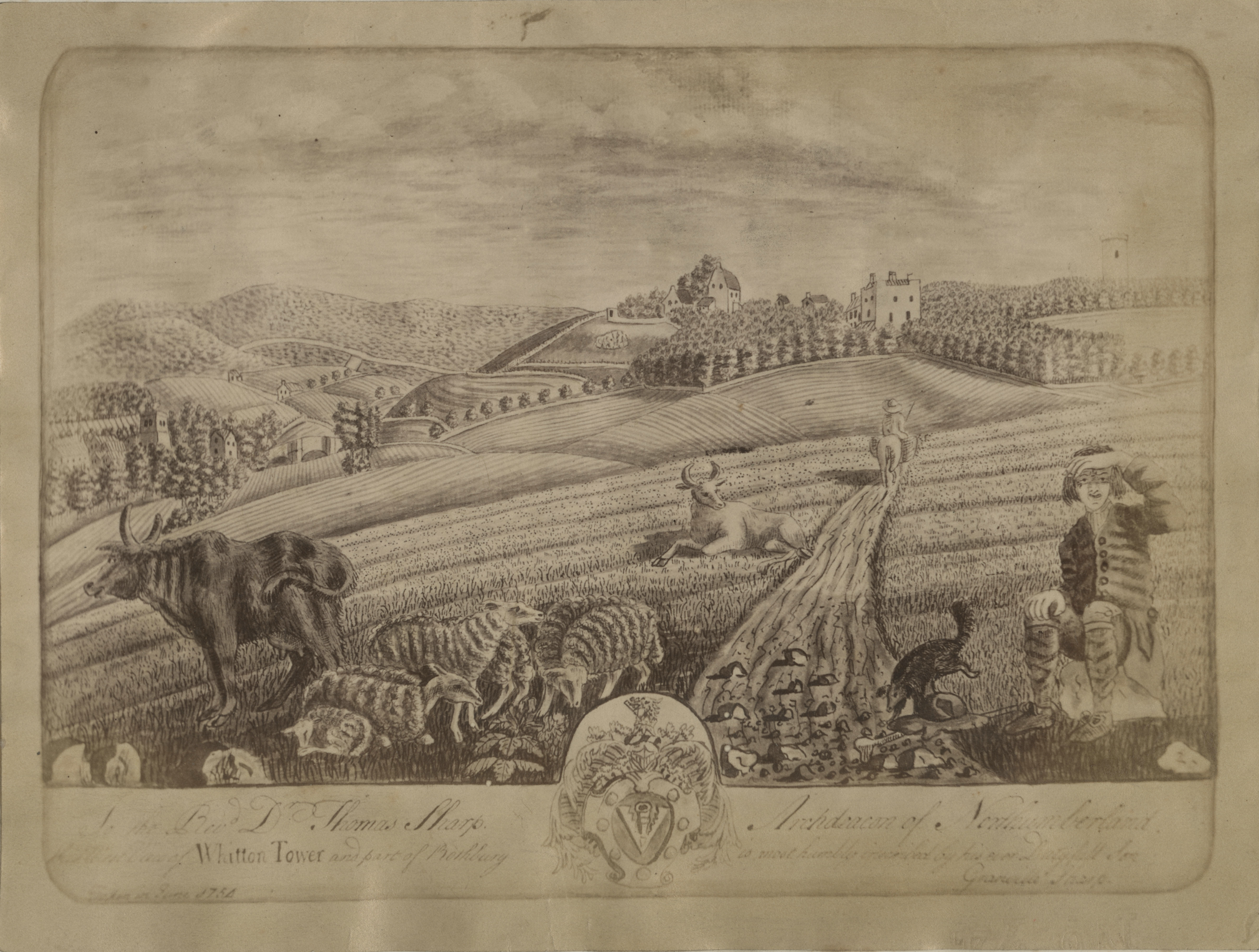
Picture to the right shows of the view looking towards Whitton Tower and also the Tower which stood at the Grange (now a ruin).
taken in 1754
during Dr Thomas Sharp residence
Major event Timeline:
Border Fury: England and Scotland at War
The border wars between England and Scotland, with legendary figures such as William Wallace (Braveheart) and Robert the Bruce, have been romanticised in poetry, prose and on film. The reality was three long and bloody centuries of conflict. John Sadler, author of new book Border Fury, says that: “There was nothing swashbuckling about this. People, regardless of age or sex, were indiscriminately slaughtered or left to starve, with crops incinerated, livestock driven off and buildings levelled.”
These are the Border Wars in which the Reivers had their own laws: It was during this period The Tower was built. There was much fighting, for the lands and rights, as these were taken from and given to others in favour by whoever ruled at the time. These were very violent times and the psychology of these conflicts have molded the peoples of this area.
Robert De UmFraville supported the Balliol and Comyn (through his mother) claims to the Scottish throne and opposed Robert Bruce who had murdered John Comyn in 1306. Robert was not suprisingly conspicuous by his absence from Bruce's first parliament at St Andrews between 1308-9. Robert fought with Ingram and was captured by the Scots at Bannockburn to be ransomed later. Robert was the lord of Redesdale when James "the Black" Douglas took Harbottle when he raided the north in 1318. account of the battles are in wikipedia http://en.wikipedia.org/wiki/James_Douglas,_Lord_of_Douglas detailing the many raids he made in weardale and the surrounding dales.
A story of one well known reiver family - Charlton - talked about the lady of the clan servering up spurs - hinting to her man that the larder was getting bare, the men went on a raiding party to "aquire" some livestock for slaughter.
1386 - Pele Tower originally built in Whitton by Sir Thomas De Umfraville, Lord of Harbottle.
Third son of Gilbert the (official) First earl of Angus and it is suggested that he became a Staller or more probably a Steward 'Valectus Regis' for Edward II and Edward III. He was at the Royal court and started a completely new branch of the family in the South.
The Pele Tower was originally built in Whitton by Sir Thomas, in order to control middle Coquetdale.
Later exchanged with the rector of nearby Rothbury.
The Tower did provided shelter and protection for the locals and their livestock, from the raiding parties of the North. These conflicts offen left the local properties in a poor state, not to mention the attempts to smoke or suffocate the protected inhabitants of the tower by wetting straw and setting fire to it at the entrances.
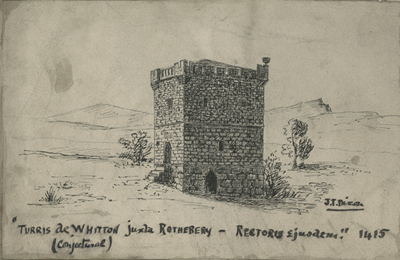
1415 - appears in roll of 1415
as being in the possession of the rector of Rothbury
"Turris de Whitton iuxta Rothebery — Rectoris eiusdem;"
Picture to the right depicts
The Pele in 1415
Note!
In my research I have taken the dates for the rectors of Rothbury from the Ecclesiastical database in preference to other documents.
There will always be some conflicts and we see the first with Alexander Cook and allegedly George Percy as rector of Rothbury.

